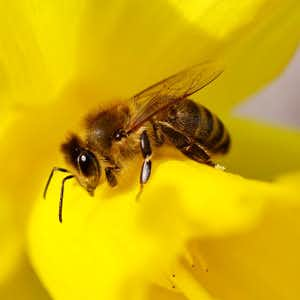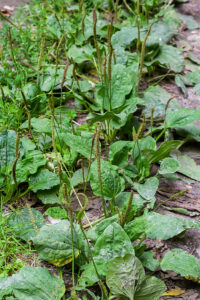
If you’ve been observing “No-Mow May” or if you just like hanging out where there are abundant wildflowers, you may have experience with bee stings. Bees generally don’t sting unless they feel threatened, but if you walk around where they are gathering nectar, you might frighten them inadvertently. Do you have a favorite remedy for bee sting? Our readers offer theirs below.
What Is the Best Remedy for a Bee Sting?
We recently invited readers to share their home remedies for bee, wasp and yellow jacket stings. Of course, an allergic reaction requires immediate medical attention. But our readers have offered some intriguing remedies to use for mild reactions.
Beekeepers Chime In:
First, we heard from some beekeepers.
Eric said:
“I’ve got a couple of beehives and sometimes get stung. I keep colloidal silver in a small spray bottle. Each time I’ve needed it, the pain disappeared immediately.”
Michael has a different solution:
“I kept bees for 25 years and always carried a small bottle of lavender essential oil to apply to stings. Relief is immediate.”
Onions to the Rescue:
We have written previously about applying the cut surface of an onion to a wasp or yellow jacket sting.
Elizabeth reports:
“I had three wasp stings—two on my upper lip and one on my hand. I only had one piece of onion, so I used it on my lip. Soon those two stings had hardly any swelling and only slight pain, but my hand became quite swollen and was very painful. The lip stings were totally gone in about two days, but the hand took over a week to resolve.”
When we first wrote about this remedy many decades ago, we checked with chemist Eric Block at the State University of New York at Albany. Dr. Block said that freshly cut onions contain an enzyme that breaks down inflammatory compounds in venom.
Meat Tenderizer as a Bee Sting Remedy:
Jo recommends a couple of favorite remedies for stings:
“Meat tenderizer or tobacco both work well to relieve the pain and swelling of stings. Make a poultice and apply it to the spot for a few minutes. Talking to the victim to get their mind off the sting while the poultice is working also helps. By the time they realize you’re trying to distract them, the pain and swelling are pretty much gone.”
Meat tenderizer breaks down protein, of course, so the theory is that it denatures the venom. We have no idea why tobacco would work, but it is an old-fashioned favorite.
Tobacco:
Here is Laura’s childhood memory:
“My father always kept a block of chewing tobacco in his pocket. When I was with him on the farm once, a yellow jacket stung me. Dad immediately chewed a small wad of tobacco and put it on the sting. It immediately stopped hurting.”
Something Sweet:
Jennifer suggested a remedy we had not encountered before:
“First, remove the bee stinger. Then take the pit out of a date and put its flesh on the sting. Any kind of date seems to work.”
Possibly in the same vein, but messier, Sharon related a dramatic story:
“I was stung by about 10 yellow jackets and the bite sites swelled to about 3-inch diameter welts. Putting honey on the stings reduced the pain and swelling. You could actually see the welt oozing as the honey seemed to be pulling out the swelling and possibly the venom.
“I recommend covering the bite area with a bandage, as the honey drips and can be quite messy. I got enough relief from the honey to justify the mess.”
We do not know which remedy will work best for any given individual. Remember, though, any reaction that affects breathing is a medical emergency.
A Handy Green Remedy for Bee Sting:
Q. My favorite home remedy is plantain for bee stings. Anyone giving tours of community gardens, as I do, should know about this.
Just take a leaf, chew it up (or instruct the person with a bee sting to chew it without swallowing it) and put the resulting paste on the bee sting. The pain will go away almost immediately.
A good garden has lots of bees and they don’t like large numbers of people in their space. Consequently, I’ve seen this home remedy used effectively on several occasions.
A. Thanks for sharing your remedy for bee sting. There are several species of plantain (Plantago sp.) that grow like weeds in North American gardens.
According to a KaiserPermanente website, a poultice of Plantago leaves might be a useful remedy for insect bites. The German Commission E, which has evaluated evidence for herbal medicines, approved its topical use for skin inflammation. We should emphasize that this is the green weed plantain, not the green banana (Musa x paradisiaca), also called plantain.

Plantago major Plantago, Plantain, fleaworts There are 3-5 parallel veins that diverge in wider leaf. The inflorescences on long stalks with short spikes numerous tiny wind-pollinated flowers.
Sliced Onion to Ease the Pain of a Sting:
Q. My daughter was pulling weeds and vines from around a tree when something flew up and stung her. I remembered reading about raw onion for stings. It immediately seemed to help. Thank you for writing about this!
A. We have heard from numerous readers who have applied raw onion to a bee or wasp sting and gotten relief. Decades ago, we spoke with Dr. Eric Block of the State University of New York. This world-renowned chemist told us that fresh-cut onions have ingredients that can break down the chemical in insect venom that causes pain and inflammation.
Not all stings respond to onion, although it seems to work pretty well on bee and wasp stings. Try it out if you have the unfortunate occasion to do so. Let us know how it works for you.
NB: A serious sting reaction requires immediate medical attention since sting allergies can be deadly.
If you don’t have plantain in your yard or an onion in the pantry, look for meat tenderizer. A paste of meat tenderizer and water can serve as a remedy for bee sting.
Cut Onion as Remedy for Wasp Stings:
Q. It seems that red wasps are the worst! I had my left arm hanging out of the window while waiting on someone to come out of the shopping plaza. The wasp flew up my sleeve without me knowing it. As I drove off, I felt a very bad stinging pain.
I pulled my shirt off and wow, a red wasp came flying out. It escaped without meeting its maker. I was stung twice.
I remembered the onion remedy, but I didn’t apply it until two days later. Voila! It works.
A. We first heard the idea of applying a freshly-cut onion to the site of a yellow jacket or wasp sting decades ago. When we checked into the basis for it, we discovered research showing that onions have enzymes that break down prostaglandins, the body chemicals that cause pain and swelling.
Meat Tenderizer Is Quick Remedy for Bee Sting:
Q. A long time ago I visited a friend in the mountains. I stepped on a wasp in the shower stall and the sting was horribly painful.
My friend put a paste made from water and meat tenderizer on the sting. Within ten minutes, the pain and swelling had totally disappeared.
Now I don’t go anywhere in the summer without meat tenderizer. Believe me, it’s come in handy more than once, especially if I drive with the window open. Just use a pinch of it, use your spit to make a paste and put it over the sting to feel it do its magic. It’s never failed, even for a bumblebee sting.
Meat Tenderizer Contains Papain:
A. We first read about using a quarter teaspoon meat tenderizer mixed with a teaspoon of water for a painful insect sting in the Journal of the American Medical Association (April 24, 1972). The doctor recommending this remedy suggested that the papain (Papay-in) in meat tenderizer breaks down the venom in the sting. It is, after all, an enzyme that breaks down proteins.
If you’ve been stung by a bumblebee or honeybee, however, the first step is to flick the stinger out with the edge of a credit card.
Using Meat Tenderizer for a Bee Sting:
Q. I used to have several beehives. Sometimes I would accidentally crush a bee when working on the hives. When that happened, they went into attack mode, and I got stung a lot.
A name-brand meat tenderizer was the ticket to take the pain away. I think it dissolved or chemically altered the venom. I’d make a paste and get it on as soon as possible.
A. Many other readers agree with you that a paste of meat tenderizer and water can ease the pain of a bee sting. This was first written up in JAMA (April 24, 1972), as we note above.
Dr. Harry Arnold wrote:
“There is, however, an immediately effective remedy for such lesions, available in most kitchens: meat tenderizer. The effectiveness of this material, applied in a dilute solution of tap water, prepared on the spot by mixing a quarter-teaspoonful or so with a teaspoonful or two of water, presumably depends on its content of papain. This proteolytic enzyme probably breaks down the venoms and kinins injected by the insect. The solution is merely rubbed into the skin at the site of the sting, and virtually all pain stops within seconds.”
As far as we can tell, there has been no rigorous research to test this treatment. If you would like to learn more about simple ways to overcome common conditions and the science to support them, you may be interested in our eGuide to Favorite Home Remedies.
An Important Warning:
People who are allergic to stings should not rely on home remedies. They must keep an epinephrine injector available and seek emergency medical attention.
Citations
- Arnold HL, "Immediate treatment of insect stings." Journal of the American Medical Association, April 24, 1972. DOI: 10.1001/jama.1972.03200040097026

